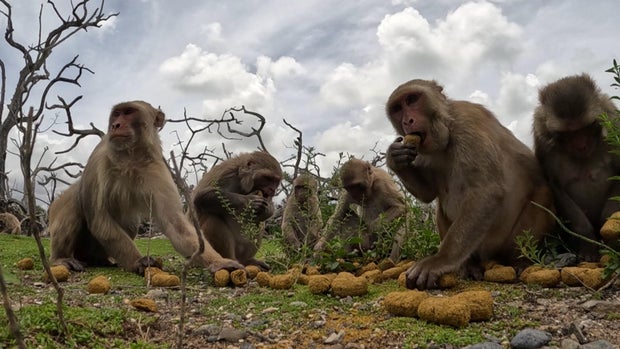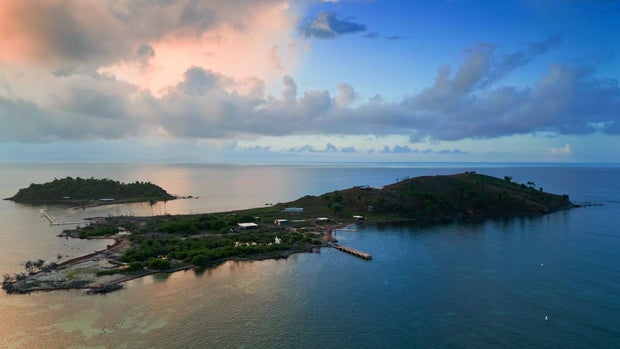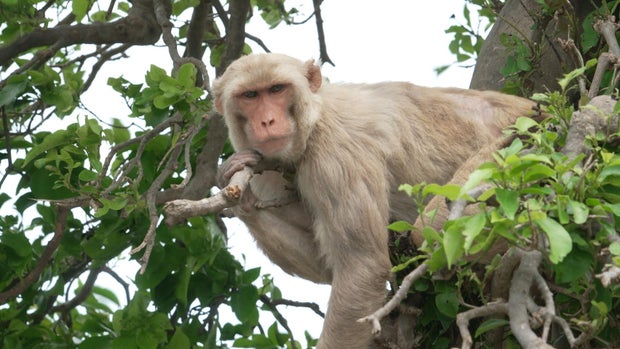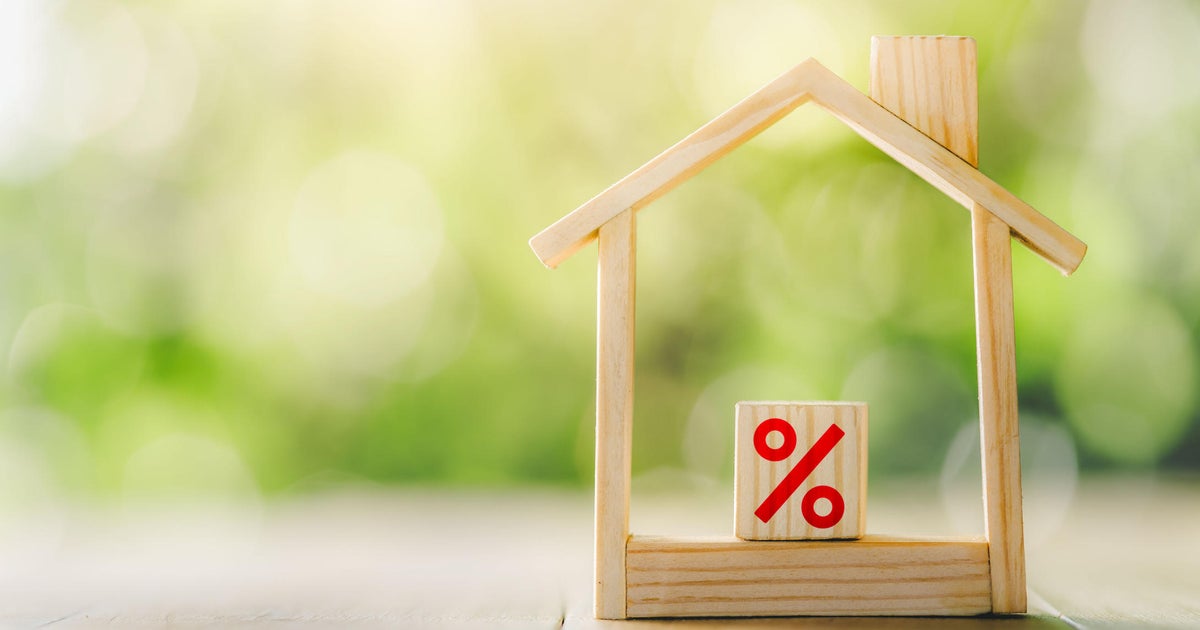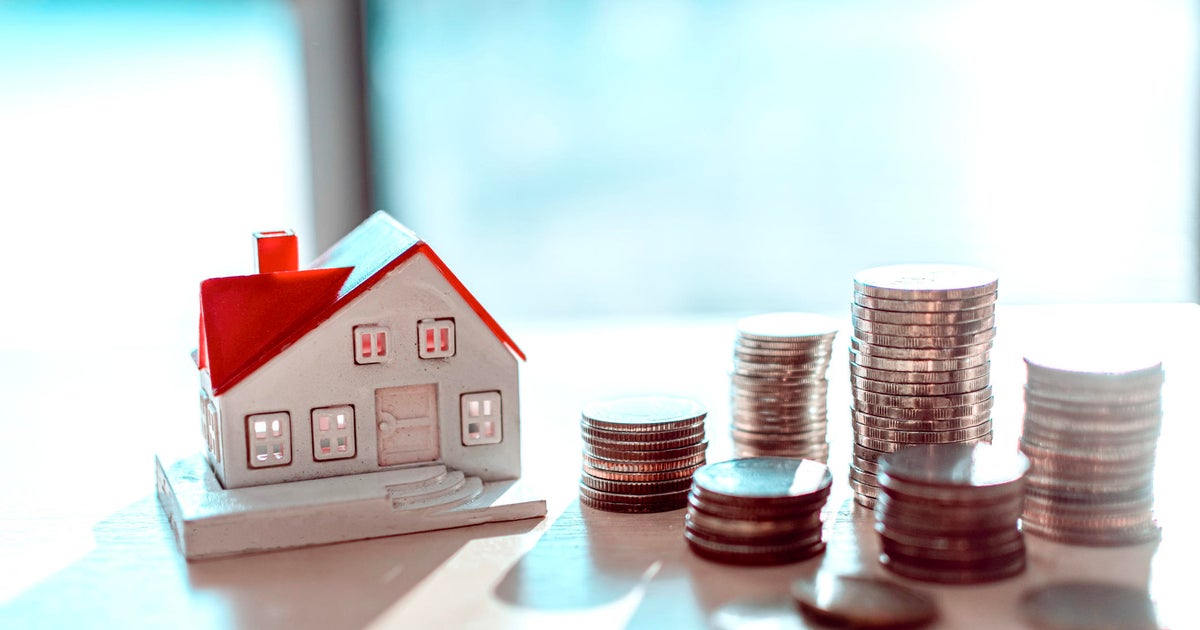On Monkey Island, scientists have rare access to more than 6 decades of biological, behavioral data
This is an updated version of a story first published on Nov. 5, 2023. The original video can be viewed here.
With extreme weather events on the rise across the globe, like the rare Category 5 hurricane that hit Mexico in October, we were interested in a study that's taking place on a remote island very few people are allowed to visit, where scientists are studying how the stress of these environmental crises effect longevity, and overall, health. As Lesley Stahl first reported in November, the subjects are not what you'd expect. They're monkeys - rhesus macaque monkeys, who've been studied there for over 80 years because 94% of their DNA, is the same as humans.
They survived with relative environmental stability until six years ago, when the island was hit with a devastating storm. After taking tests for tuberculosis, measles, and COVID, Lesley and her team were allowed to visit the island called Cayo Santiago - or Monkey Island-- off the coast of Puerto Rico.
There are roughly 1,800 monkeys on Cayo… they live in isolation in what is a natural laboratory – halfway between captivity and the way they would live in the wild.
Biologists James Higham of NYU and Noah Snyder-Mackler of Arizona State University are part of a team of investigators in this long-term research project.
Lesley Stahl: What's the lifespan usually?
Noah Snyder-Mackler: The lifespan here on the island for the females, the median lifespan, is about 18 years. And then in males, about-- about 15 years, right?
Lesley Stahl: Do they have- is there a predator?
James Higham: No predators here.
Another way life here is unlike the wild is that these guys are served their meals every morning. Researchers tell us there's a hierarchy. The highest-ranking monkeys get to eat first.
James Higham: I've even seen high ranking individuals go up to a low-ranking individual who is eating food in their mouth and hold their mouth open and--
Lesley Stahl: No.
James Higham: --take the food out of their mouths and then close it (laugh)
Lesley Stahl: What do they get?
Noah Snyder-Mackler: Purina Monkey Chow. (laugh)
Lesley Stahl: There's Monkey Chow?
Noah Snyder-Mackler: Made by--
James Higham: There is.
Noah Snyder-Mackler: --Purina.
James Higham: Yeah.
Lesley Stahl: Oh my goodness—
Rhesus monkeys are commonly used for medical research because they're our close relatives, genetically and physiologically similar to humans.
James Higham: They have systems that are quite like us, eyes that are like us, lungs and hearts that are like us.
These rhesus macaque monkeys - their ancestors – came here from India in 1938.
American primatologist Clarence Carpenter took 500 of them on a grueling 14,000 mile sea voyage that lasted 51 days.
He wanted to create a naturalistic research facility to study the monkeys' social and sexual behaviors.
Their early years here were tough -- many died from disease. but enough of them lived on so that by the 1950s, scientists began tattooing them, and taking a daily census.
That meticulous record keeping has continued with today's monkeys, all of whom descended from the original group, giving scientists rare access to more than six decades of their biological and behavioral data.
One of things they learned is that they're highly adaptable, acclimating quickly to the island. They also learned that they can be quite aggressive especially around food and during the mating season…
Lesley Stahl: Are these monkeys-- intelligent?
Noah Snyder-Mackler: Sure. They're-- they're pretty s-- they're pretty intelligent. You know, they're socially intelligent.
Lesley Stahl: How similar to us are they in how they live?
Noah Snyder-Mackler: They form really strong social relationships with their-- best friends and their family members.
Lesley Stahl: They have best friends?
Noah Snyder-Mackler: Some close friends – some best friends, right.
Rhesus monkeys live in female-led societies: mothers, daughters, aunts and grandmothers stick together in groups, while the males leave when they reach maturity and join other troops for breeding.
Few people know the troop tensions and allegiances better than research assistants Daniel Phillips and Josue Negron who've worked on Cayo for years. They arrive every morning by boat at 7 a.m. and for the next seven hours, they document things like aggression, grooming, vigilance and feeding.
Lesley Stahl: Do you ever get to know individuals? In other words, you know that monkey versus that one?
Josue Negron: Yeah, we-- we need to recognize them right away. Because I need to know like, who is interacting with who, how they, like groom each other, or attack each other.
Lesley Stahl: And how can you tell the difference? What are-- what are the characteristics that you see?
Daniel Phillips: You can see the differences on even how they walk, how they move- Their even-- faces have differences
Lesley Stahl: In other words, their faces become as ordinary in a way to your eyes as human faces?
Josue Negron: Yeah.
Daniel Phillips: Yes.
Josue Negron: You can recognize even families.
Daniel Phillips: Exactly.
Josue Negron: Like, your face is familiar, you should-- you should be the son of this female.
Everything changed for the research and the monkeys when Hurricane Maria slammed into Puerto Rico in September 2017.
One hundred fifty five mile-an-hour winds smashed into homes and office buildings, destroying everything in sight, including the power grid and communication systems. Nearly 3,000 people died.
There was no way for the team to get to Monkey Island.
Angelina Ruiz-Lambides, the then-scientific director of Cayo, seven months pregnant at the time, sheltered in her home outside of San Juan with her husband and two young children.
Lesley Stahl: You thought the monkeys were all gonna-
Angelina Ruiz-Lambides: Yeah, we--
Lesley Stahl: --die.
Angelina Ruiz-Lambides: --thought that the monkeys were going--
Angelina Ruiz-Lambides: --to die.
James Higham and Noah Snyder-Mackler couldn't get any news about their colleagues or the monkeys. So, two days after the storm, the team came up with an idea.
Lesley Stahl: And you hired a helicopter?
James Higham: We hired a helicopter.
They enlisted the pilot to fly over Cayo and do a survey.. and they had a list of questions.
James Higham: Can he see any monkeys? Are they alive? What is the status of the vegetation? Are there standing pools of water that they might be able to drink?
Angelina, who had decided to go up with the pilot, was horrified. This is footage she shot from the helicopter.
Angelina Ruiz-Lambides: I see this destruction, like, 80 plus years of work completely flattened.
This is Cayo before the hurricane with a dense canopy of trees, and lush foliage.
This is after…a green oasis turned brown, buried in dead branches. The island lost two-thirds of its vegetation.
Heartbroken by what she was seeing from the air, Angelina wanted a closer look. but even on the ground, she didn't see any monkeys.
Angelina Ruiz-Lambides: So then I get on the helicopter again
Lesley Stahl: Back up again
Angelina Ruiz-Lambides: And that's when I see a social group running from the helicopter. And so I go, "There's monkeys. There's still Cayo."
Angelina Ruiz-Lambides: I think I estimated, okay, those-- that must be around, like, 300, 400 monkeys or so. So--
Lesley Stahl: Out of 1,700.
Angelina Ruiz-Lambides: Yes.
But once the staff was able to return and do a complete census on the ground, they found, to their utter astonishment, that most had lived. They estimated just about 50 had died.
Lesley Stahl: And you're thinking, "How could they survive this?" How could they?
Angelina Ruiz-Lambides: How could they survive this?
It's still a mystery. What did the monkeys do to ride out the storm? Where did they shelter from the wind? And what did they eat?
Lesley Stahl: So, one of the big questions is without being fed, how were they nourished?
James Higham: Yeah, so, although the hurricane did dramatically de-vegetate the island, one thing it also did was deposited a great amount of seaweed and algae onto the island. And so, one possibility is that the monkeys were eating more of this kind of vegetation.
Which they still seem to enjoy.
After the hurricane, the monkeys had to adjust to a new, far more hostile environment. their innate adaptability certainly helped.
Six years after the storm, the adjusting continues.
Attempts to replant the trees have been stymied because the monkeys -– ever curious about anything new in their environment-- uproot them before they have a chance to grow, so now there's very little shade.
Lesley Stahl: This used to be almost forested, right?
Noah Snyder-Mackler: Lots of space and shade.
James Higham: And now they're forced to sit in a few shaded areas. And so they've been clumped by the-- changing distribution of shade.
James Higham: So an interesting thing that we saw is that individuals became more social.
Not just more social. The researchers have noticed that the monkeys are more tolerant of each other, which, at first, seemed counterintuitive.
Lesley Stahl: I'm thinking of humans in a situation where there's fewer resources, and I see in my mind's eye competition. I see them saying get off my property or whatever. But you're saying that it was the opposite here.
James Higham: Perhaps. But there's also famous examples of people pulling together. So, I think it can go both ways, we're capable of great greed and competition and-- and cruelty. But humans are also capable of great kindness and compassion and friendship and generosity. And-- that kind of duality exists in rhesus macaque societies too.
Noah Snyder-Mackler: And I think anyone you talk to here in Puerto Rico would-- would bring up the fact that they, you know, the people of Puerto Rico sort of gelled and increased their support of one another in the face of this event.
Beyond observing their social interactions, they were also able to track biological changes since they had access to blood tests done on the monkeys for 13 years.
Noah Snyder-Mackler: So what we found is that individuals who had lived through the hurricane had immune systems that looked like they had aged an extra two years.
Lesley Stahl: What is that in human years?
Noah Snyder-Mackler: It's six to eight human years.
Lesley Stahl: They aged s-- six to eight years?
Noah Snyder-Mackler: They aged six to eight human years.
Lesley Stahl: Oh my gosh. Through the trauma.
Noah Snyder-Mackler: That was on average. That's the work that we're trying to do right now is, what makes some of these individuals more resilient to the hurricane, right?
Lesley Stahl: Is the hypothesis that it has something to do with friendships?
Noah Snyder-Mackler: We think that those individuals who were able to have stronger bonds, stronger friendships might have been protected from this really stressful event.
The hurricane opened all new avenues of their research with questions such as what predicts who survives a catastrophe like an earthquake or a hurricane and how quickly they recover.
Lesley Stahl: So when you step back and look at your study in terms of climate-related trauma or any kind of trauma-- are you expecting to find answers for survivability in these situations for human beings?
Noah Snyder-Mackler: Given the strong similarity between these primates, these monkeys and us, we know that a lot of this-- the-- the work that we're doing and-- and the things that they might do to, you know, be more resilient to this might be translatable to humans, to us. And might provide ways for us to intervene and help buffer against the negative effects of these traumatic events.
Produced by Ayesha Siddiqi. Associate producer, Kate Morris. Broadcast associate, Wren Woodson. Edited by Craig Crawford.
for more features.

